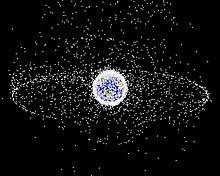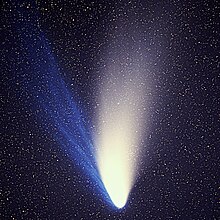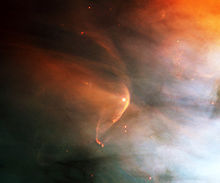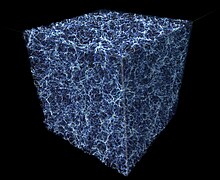This is all getting even too rarified for me at this point. I think I have drilled down into this subject as far as I personally can go for now.
begin quote from:
Regions
Regions near the Earth
Space in proximity to the Earth is physically similar to the remainder of interplanetary space, but is home to a multitude of Earth–orbiting satellites and has been subject to extensive studies. For identification purposes, this volume is divided into overlapping regions of space.[95][96][97][98]
Near-Earth space is the region of space extending from low Earth orbits out to geostationary orbits.[95] This region includes the major orbits for artificial satellites and is the site of most of humanity's space activity. The region has seen high levels of space debris, sometimes dubbed space pollution, threatening any space activity in this region.[95] Some of this debris re-enters Earth's atmosphere periodically.[99] Although it meets the definition of outer space, the atmospheric density inside low-Earth orbital space, the first few hundred kilometers above the Kármán line, is still sufficient to produce significant drag on satellites.[94]

Geospace is a region of space that includes Earth's upper atmosphere and magnetosphere.[96] The Van Allen radiation belts lie within the geospace. The outer boundary of geospace is the magnetopause, which forms an interface between the Earth's magnetosphere and the solar wind. The inner boundary is the ionosphere.[101][102]
The variable space-weather conditions of geospace are affected by the behavior of the Sun and the solar wind; the subject of geospace is interlinked with heliophysics—the study of the Sun and its impact on the planets of the Solar System.[103] The day-side magnetopause is compressed by solar-wind pressure—the subsolar distance from the center of the Earth is typically 10 Earth radii. On the night side, the solar wind stretches the magnetosphere to form a magnetotail that sometimes extends out to more than 100–200 Earth radii.[104][105] For roughly four days of each month, the lunar surface is shielded from the solar wind as the Moon passes through the magnetotail.[106]
Geospace is populated by electrically charged particles at very low densities, the motions of which are controlled by the Earth's magnetic field. These plasmas form a medium from which storm-like disturbances powered by the solar wind can drive electrical currents into the Earth's upper atmosphere. Geomagnetic storms can disturb two regions of geospace, the radiation belts and the ionosphere. These storms increase fluxes of energetic electrons that can permanently damage satellite electronics, interfering with shortwave radio communication and GPS location and timing.[107] Magnetic storms can be a hazard to astronauts, even in low Earth orbit. They create aurorae seen at high latitudes in an oval surrounding the geomagnetic poles.[108]

xGeo space is a concept used by the US to refer to space of high Earth orbits, ranging from beyond geosynchronous orbit (GEO) at approximately 35,786 km (22,236 mi),[97] out to the L2 Earth-Moon Lagrange point at 448,900 km (278,934 mi). This is located beyond the orbit of the Moon and therefore includes cislunar space.[109] Translunar space is the region of lunar transfer orbits, between the Moon and Earth.[110] Cislunar space is a region outside of Earth that includes lunar orbits, the Moon's orbital space around Earth and the Lagrange points.[98]
The region where a body's gravitational potential remains dominant against gravitational pontentials from other bodies, is the body's sphere of influence or gravity well, mostly described with the Hill sphere model.[111] In the case of Earth this includes all space from the Earth to a distance of roughly 1% of the mean distance from Earth to the Sun,[112] or 1.5 million km (0.93 million mi). Beyond Earth's Hill sphere extends along Earth's orbital path its orbital and co-orbital space. This space is co-populated by groups of co-orbital Near-Earth Objects (NEOs), such as horseshoe librators and Earth trojans, with some NEOs at times becoming temporary satellites and quasi-moons to Earth.[113]
Deep space is defined by the United States government as region of space beyond low-Earth orbit, including cislunar space.[114] Others vary the starting point from beyond cislunar space to beyond the Solar System.[115][116][117] The International Telecommunication Union responsible for radio communication, including with satellites, defines the beginning of deep space at 2 million km (1.2 million mi),[118] which is about five times the Moon's orbital distance.[119]

Interplanetary space

Interplanetary space is defined by the solar wind, a continuous stream of charged particles emanating from the Sun that creates a very tenuous atmosphere (the heliosphere, the Sun's astrosphere) for billions of kilometers into space. This wind has a particle density of 5–10 protons/cm3 and is moving at a velocity of 350–400 km/s (780,000–890,000 mph).[120] Interplanetary space extends out to the heliopause (the Sun's astropause) where the influence of the galactic environment starts to dominate over the magnetic field and particle flux from the Sun.[121] The distance and strength of the heliopause varies depending on the activity level of the solar wind.[122] The heliopause in turn deflects away low-energy galactic cosmic rays, with this modulation effect peaking during solar maximum.[123]
The volume of interplanetary space is a nearly total vacuum, with a mean free path of about one astronomical unit at the orbital distance of the Earth. This space is not completely empty, and is sparsely filled with cosmic rays, which include ionized atomic nuclei and various subatomic particles. There is gas, plasma and dust,[124] small meteors, and several dozen types of organic molecules discovered to date by microwave spectroscopy.[125] A cloud of interplanetary dust is visible at night as a faint band called the zodiacal light.[126]
Interplanetary space contains the magnetic field generated by the Sun.[120] There are magnetospheres generated by planets such as Jupiter, Saturn, Mercury and the Earth that have their own magnetic fields. These are shaped by the influence of the solar wind into the approximation of a teardrop shape, with the long tail extending outward behind the planet. These magnetic fields can trap particles from the solar wind and other sources, creating belts of charged particles such as the Van Allen radiation belts. Planets without magnetic fields, such as Mars, have their atmospheres gradually eroded by the solar wind.[127]
Interstellar space

Interstellar space is the physical space outside the bubbles of plasma, known as astrospheres, formed by stellar winds originating from individual stars.[128] It is the space between the stars or stellar systems within a nebula or galaxy.[129] Interstellar space contains an interstellar medium of sparse matter and radiation. The boundary between an astrosphere and interstellar space is known as an astropause. For the Sun, the astrosphere and astropause are called the heliosphere and heliopause.
Approximately 70% of the mass of the interstellar medium consists of lone hydrogen atoms; most of the remainder consists of helium atoms. This is enriched with trace amounts of heavier atoms formed through stellar nucleosynthesis. These atoms are ejected into the interstellar medium by stellar winds or when evolved stars begin to shed their outer envelopes such as during the formation of a planetary nebula.[130] The cataclysmic explosion of a supernova propagates shock waves of stellar ejecta outward, distributing it throughout the interstellar medium, including the heavy elements previously formed within the star's core.[131] The density of matter in the interstellar medium can vary considerably: the average is around 106 particles per m3,[132] but cold molecular clouds can hold 108–1012 per m3.[38][130]
A number of molecules exist in interstellar space, which can form dust particles as tiny as 0.1 μm.[133] The tally of molecules discovered through radio astronomy is steadily increasing at the rate of about four new species per year. Large regions of higher density matter known as molecular clouds allow chemical reactions to occur, including the formation of organic polyatomic species. Much of this chemistry is driven by collisions. Energetic cosmic rays penetrate the cold, dense clouds and ionize hydrogen and helium, resulting, for example, in the trihydrogen cation. An ionized helium atom can then split relatively abundant carbon monoxide to produce ionized carbon, which in turn can lead to organic chemical reactions.[134]
The local interstellar medium is a region of space within 100 pc of the Sun, which is of interest both for its proximity and for its interaction with the Solar System. This volume nearly coincides with a region of space known as the Local Bubble, which is characterized by a lack of dense, cold clouds. It forms a cavity in the Orion Arm of the Milky Way galaxy, with dense molecular clouds lying along the borders, such as those in the constellations of Ophiuchus and Taurus. (The actual distance to the border of this cavity varies from 60 to 250 pc or more.) This volume contains about 104–105 stars and the local interstellar gas counterbalances the astrospheres that surround these stars, with the volume of each sphere varying depending on the local density of the interstellar medium. The Local Bubble contains dozens of warm interstellar clouds with temperatures of up to 7,000 K and radii of 0.5–5 pc.[135]
When stars are moving at sufficiently high peculiar velocities, their astrospheres can generate bow shocks as they collide with the interstellar medium. For decades it was assumed that the Sun had a bow shock. In 2012, data from Interstellar Boundary Explorer (IBEX) and NASA's Voyager probes showed that the Sun's bow shock does not exist. Instead, these authors argue that a subsonic bow wave defines the transition from the solar wind flow to the interstellar medium.[136][137] A bow shock is a third boundary characteristic of an astrosphere, laying outside the termination shock and the astropause.[137]
Intergalactic space

Intergalactic space is the physical space between galaxies. Studies of the large-scale distribution of galaxies show that the universe has a foam-like structure, with groups and clusters of galaxies lying along filaments that occupy about a tenth of the total space. The remainder forms cosmic voids that are mostly empty of galaxies. Typically, a void spans a distance of 7–30 megaparsecs.[138]
Surrounding and stretching between galaxies, there is a rarefied plasma[139] that is organized in a galactic filamentary structure.[140] This material is called the intergalactic medium (IGM). The density of these filaments of intergalactic medium is about one atom per cubic meter,[141] which is 5–200 times the average density of the universe[142] after including the cosmic voids. The IGM is inferred to be mostly primordial in composition, with 76% hydrogen by mass, and enriched with higher mass elements from high-velocity galactic outflows.[143]
As gas falls into the intergalactic medium from the voids, it heats up to temperatures of 105 K to 107 K,[3] which is high enough so that collisions between atoms have enough energy to cause the bound electrons to escape from the hydrogen nuclei; this is why the IGM is ionized. At these temperatures, it is called the warm–hot intergalactic medium (WHIM). (Although the plasma is very hot by terrestrial standards, 105 K is often called "warm" in astrophysics.) Computer simulations and observations indicate that up to half of the atomic matter in the universe might exist in this warm–hot, rarefied state.[142][144][145] When gas falls from the filamentary structures of the WHIM into the galaxy clusters at the intersections of the cosmic filaments, it can heat up even more, reaching temperatures of 108 K and above in the so-called intracluster medium (ICM).[146]
No comments:
Post a Comment